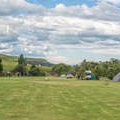Introduction to Medieval Divination in Britain
During the medieval period, divination practices occupied a unique space within British society, blending superstition, religious dogma, and evolving scientific curiosity. Across the British Isles, people sought guidance from the supernatural to navigate uncertainties in daily life—whether these related to personal fortunes, community well-being, or political decisions. Far from being relegated to the fringes of society, divinatory arts such as geomancy, astrology, and augury were often employed by nobles, clergy, and common folk alike. The prevailing cultural context was marked by a pervasive belief in unseen forces influencing earthly affairs; this worldview was reinforced by both Christian doctrine (which acknowledged miracles and divine intervention) and lingering pagan traditions. As such, divination served as an accepted means of interpreting fate and deciphering divine will. In this environment, geomancy emerged not merely as a mystical pastime but as a practical tool for decision-making, reflecting the era’s complex relationship with magic, faith, and the quest for certainty.
2. The Origins and Principles of Geomancy
Geomancy, a form of divination based on interpreting patterns made by tossing soil or drawing marks in the earth, has its roots in the ancient civilisations of North Africa and the Middle East. Over centuries, this mysterious art migrated across the Mediterranean into continental Europe, eventually embedding itself within the medieval British consciousness. The arrival of geomancy in Britain coincided with a broader wave of esoteric knowledge that swept through monastic centres and royal courts during the Middle Ages.
The Historical Journey: From Desert Sands to British Soil
Geomancy’s earliest documented practice is traced back to Arabic scholars who refined and systematised its principles. The technique was introduced to Europe during the 12th century, largely through the translation movement centred in Spain and Sicily. British scholars encountered geomancy as part of a wider fascination with astrology, alchemy, and other occult sciences. By the late medieval period, geomantic manuals were circulating among learned circles in England, Scotland, and Wales.
Key Principles of Geomancy
At its core, geomancy relies on generating random marks—traditionally sixteen lines of dots—which are then grouped into four-line figures called “Mother Figures.” These figures are interpreted according to strict rules, often supplemented by astrological correspondences.
Basic Elements of Medieval Geomantic Practice
| Element | Description |
|---|---|
| Generation of Marks | Randomly create lines or dots (often using soil or parchment) to ensure chance plays a role. |
| Formation of Figures | Combine marks into sixteen standard patterns (“figures”), each with symbolic meanings. |
| Chart Construction | Arrange figures into a geomantic chart (shield chart) for interpretation. |
| Interpretation | Analyse positions and relationships between figures to answer specific questions. |
This structured yet intuitive process allowed medieval Britons to address uncertainties ranging from personal fortunes to political strategy. Its adaptability and apparent simplicity contributed to its widespread appeal across all social strata.

3. Geomancy in the British Isles: Adaptation and Practice
During the medieval period, geomancy was not merely an imported curiosity; it underwent significant transformation as it traversed England, Wales, and Scotland. While its roots were embedded in Arabic and Continental traditions, local practitioners across the British Isles began to reinterpret and adapt geomantic methods to reflect their own cultural contexts and needs.
In England, geomancy gained traction among both learned scholars and laypeople. Monastic communities, such as those at Oxford and Cambridge, translated Latin texts on geomancy, infusing the practice with Christian symbolism and moral overtones. Manuals circulated that simplified complex calculations, making the art more accessible to those outside ecclesiastical circles. The English approach often emphasised practical divination—using geomancy for decisions about land inheritance, marriage prospects, or even the outcome of royal disputes.
Wales, with its rich tradition of bardic lore and native prophecy, absorbed geomancy into existing frameworks of folk magic and oral wisdom. Welsh geomancers would blend imported techniques with indigenous practices such as cyfarwyddiaid (storytellers or wise men), who used patterns in nature as omens. Here, geomancy was less formalised than in England but more deeply entwined with landscape features like standing stones or ancient mounds, which were believed to hold mystical significance.
Meanwhile, in Scotland, regional adaptations reflected a synthesis of Norse influence and Celtic custom. Scottish lairds and clan leaders sometimes consulted geomancers before battles or important negotiations, seeking guidance on fate and fortune. In the Highlands, where oral tradition dominated, geomantic symbols were occasionally incorporated into ritual objects or woven into tales recited by seannachies (traditional storytellers). The practice maintained a pragmatic focus, often employed in matters of survival—weather prediction or livestock health.
Despite these regional distinctions, a common thread ran through medieval British geomancy: its ability to respond flexibly to local beliefs while offering a structured means of confronting uncertainty. Whether practised in monastic scriptoriums or rural farmsteads, geomancy became a uniquely British synthesis—part scholarly pursuit, part folk tradition—shaping decisions that rippled through generations.
4. Influence on Decision-Making and Everyday Life
Geomancy’s impact in medieval Britain extended far beyond the realm of esoteric curiosity; it became a practical tool, shaping choices at both individual and institutional levels. The British interpreted geomantic readings to guide decisions in agriculture, politics, law, and personal fortune—domains crucial to societal stability and individual well-being.
Agricultural Applications
In agrarian communities, geomancy was often consulted before sowing seeds, harvesting crops, or managing livestock. Landowners and farmers would cast charts to determine auspicious times for planting or predict weather patterns. This helped mitigate risks associated with poor harvests or natural disasters.
| Area | Typical Geomantic Question | Influence on Decision |
|---|---|---|
| Planting Crops | When is the most favourable time to sow? | Altered planting schedules based on readings |
| Livestock | Will the herd prosper this season? | Adjusted grazing or trading plans |
Political and Legal Implications
The political elite and legal authorities sometimes turned to geomancy when confronted with uncertainty or contentious issues. Rulers could seek guidance before embarking on military campaigns or forging alliances. Likewise, local magistrates might consult a geomancer regarding the resolution of disputes or the selection of trustworthy officials.
| Context | Decision Type | Role of Geomancy |
|---|---|---|
| Court Cases | Guilt/innocence determination | Sought moral clarity from geomantic charts |
| Council Decisions | Treaty negotiations or appointments | Assessed omens for best outcomes |
Shaping Personal Fortunes
For individuals, geomancy offered a method to navigate the uncertainties of daily life. People frequently asked about marriage prospects, business ventures, travel safety, or health concerns. Readings could encourage bold action, urge caution, or provide reassurance during turbulent times.
The Enduring Social Impact
The widespread use of geomancy embedded it in the fabric of British medieval life. Its influence was not limited to moments of crisis; rather, it provided a framework for interpreting the unknown and making informed choices. By integrating mystical insight with practical affairs, medieval Britons sought to harmonise fate and reason—a testament to their resourcefulness and adaptability.
5. Case Studies: Notable Examples of Geomancy in Action
Throughout medieval Britain, geomancy was more than an abstract theory; it manifested in the decisions of influential figures and shaped key historical moments. By examining documented cases, we gain insight into how this form of divination impacted British fortunes and decision-making processes.
The Royal Court and Geomantic Consultation
One compelling example comes from the reign of Henry II in the 12th century. Chronicles such as those by Gerald of Wales allude to the use of “earth divinations” at court, where geomancers were reportedly consulted before embarking on significant military campaigns or diplomatic missions. Although direct documentation is scarce, letters between courtiers reference “casting shields upon the earth” for guidance, a likely nod to geomantic practice.
Ecclesiastical Endorsement: The Case of Robert Grosseteste
Robert Grosseteste, Bishop of Lincoln in the 13th century, was known for his scholarly interest in the natural sciences and esoteric arts. While he cautioned against superstition, records in the Lincoln Cathedral archives indicate that he once sanctioned a geomancer’s reading to determine the most auspicious date for consecrating a new chapel. This event underscores the cautious integration of geomancy within both religious and administrative contexts.
The Wars of the Roses: Strategic Decisions
During the tumultuous Wars of the Roses (15th century), noble houses frequently sought any advantage, including divinatory practices. The Paston Letters—a collection of correspondence from a prominent Norfolk family—reveal that geomancers were occasionally employed to advise on matters ranging from estate management to battle timing. In one letter, John Paston refers cryptically to “the points and figures being favourable,” suggesting geomantic consultation before a risky political move.
Legal Precedents and Public Perception
Court records from York and London in the late Middle Ages show that disputes occasionally arose over the legitimacy of using geomancy to settle property boundaries or inheritance claims. While some judges dismissed these practices as mere superstition, others recognised their local authority, particularly in rural communities where tradition held sway. These cases highlight both the cultural penetration and contested status of geomancy within English legal frameworks.
Together, these examples illustrate that geomancy was woven into the fabric of medieval British life—not merely as folklore but as a practical tool influencing decisions at every level of society. Whether guiding monarchs or mediating village disputes, its legacy offers a fascinating window into the mindset and methodologies of the era.
6. Long-Term Legacy and Modern Perceptions
The Lingering Footprint of Geomancy in British Culture
While the medieval heyday of geomancy has long passed, its influence on British society has left a subtle but persistent mark. In the centuries following its peak, geomancy gradually receded from mainstream use, overshadowed by the rise of scientific rationalism and changing religious attitudes during the Renaissance and Enlightenment periods. Nevertheless, the echoes of this once-respected art can still be traced through the fabric of British culture, both in historical memory and occasional modern revivals.
From Medieval Authority to Arcane Curiosity
Geomancy’s decline was not abrupt but rather a gradual fading as intellectual paradigms shifted. By the seventeenth century, it had become more associated with folklore and antiquarian interests than with practical decision-making or fortune-telling. The rise of empirical science relegated geomancy to the fringes, where it became a subject for collectors of arcana and those fascinated by Britain’s mystical past. Yet, references to geomantic practices persisted in literature, local traditions, and even landscape design—subtly informing concepts of harmony between land, fate, and human activity.
Modern Reappraisal and Cultural Memory
In contemporary Britain, geomancy occupies an ambiguous space between historical curiosity and niche spiritual practice. While few today consult geomancers for guidance on national policy or personal fortune, there is renewed scholarly interest in understanding how such beliefs shaped earlier societies. Museums, academic publications, and heritage sites occasionally highlight geomancy within broader explorations of medieval life and thought. Additionally, a small but dedicated community—often linked to neo-pagan or esoteric circles—continues to experiment with geomantic techniques, seeing them as part of Britain’s spiritual heritage rather than obsolete superstition.
Conclusion: Enduring Symbolism and Revival
Geomancy’s legacy in Britain lies less in its active practice than in its symbolic resonance: a reminder of times when divination shaped momentous decisions and reflected deep cultural anxieties about fate and order. As British society periodically revisits its medieval roots—in literature, festivals, or alternative spirituality—geomancy endures as a touchstone for exploring the interplay between belief, environment, and destiny. Its story serves as both a cautionary tale about the limits of certainty and a testament to humanity’s enduring quest for meaning amidst uncertainty.


